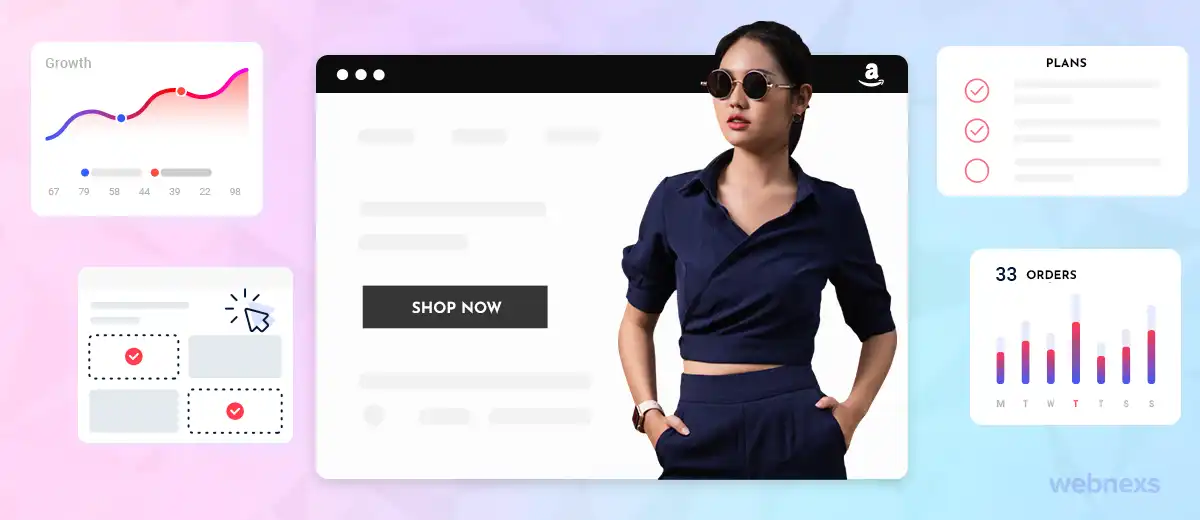Hello, Trend Trackers!
Launching an online marketplace like Amazon requires thoughtful analysis and a strong online marketplace business plan. If you aim to create a platform that hosts multiple vendors, developing a clear business plan is the crucial first step toward building a successful and sustainable marketplace.
This guide will walk you through the essential steps, from understanding market trends to creating effective revenue generation strategies. Whether starting from scratch or refining an existing business model, the information here will help you succeed in the competitive online marketplace industry.
Ready to build your online marketplace?
Request a free demo today and get personalized support in crafting a business plan tailored to your goals.
The opportunities in ecommerce are vast. Let’s explore what’s possible and turn your vision into a thriving online marketplace!
They have surely visualized and realized the vast potential of ecommerce very soon and explored the outcome of the online multi-vendor marketplace. Let’s talk numbers.
Launch Your Multi-Vendor Marketplace Plan Today!
Great Online Global Ecommerce Sales Statistics(2025 to 2030)
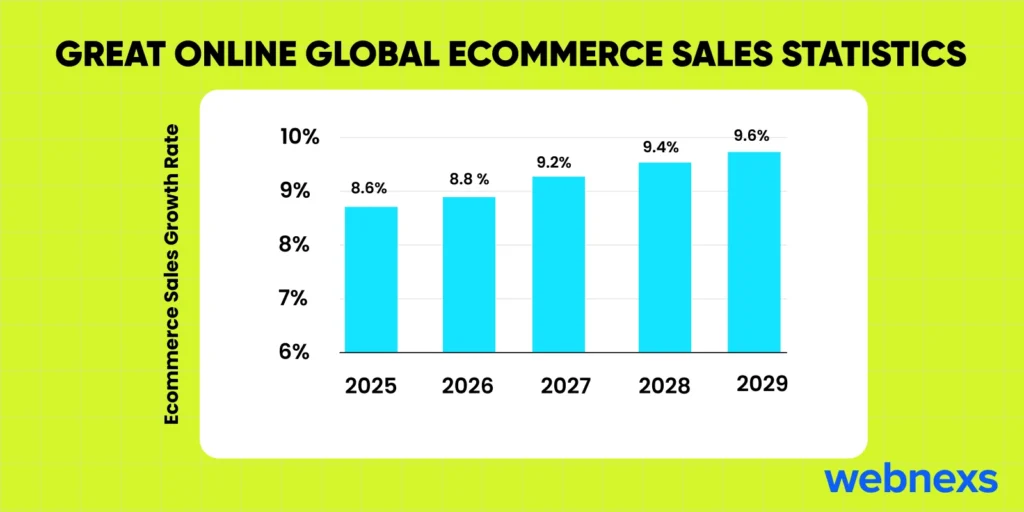
The projected global ecommerce growth rate for the year 2025 is expected to stabilize at 8.6%, driving global ecommerce sales to approximately $7.9 trillion worldwide.
Industry experts remain optimistic about the sustained growth of global ecommerce, predicting consistent expansion over the coming years.
In 2026, the growth rate is anticipated to hold steady at 8.6%, with total ecommerce sales forecasted to reach $8.6 trillion. Moving into 2027, the growth rate is projected to dip slightly to 7.9%, pushing total ecommerce sales beyond the $9.3 trillion mark.
By 2028, the global ecommerce growth rate is expected to moderate further to 7.4%, resulting in a sales figure of $10 trillion. In 2029, growth will decelerate slightly to 7.1%, marking another milestone with total sales reaching $10.8 trillion.
Looking ahead to 2030, industry forecasts predict a growth rate of 6.8%, propelling ecommerce sales to an impressive $11.5 trillion globally. This period from 2025 to 2030 signifies a cumulative increase of $3.6 trillion in total ecommerce sales, reflecting robust growth and highlighting the sector’s enduring potential.
The dynamic evolution of ecommerce continues to offer significant opportunities for businesses and consumers alike, solidifying its position as a cornerstone of global retail.
Key Takeaways on Marketplace Business Plan
- To create a strong business plan for your online marketplace, begin by researching the market carefully. This will help you understand what customers want and where your platform can meet their needs.
- Your business plan should clearly explain the business model you’ll use, such as B2B (business-to-business) or B2C (business-to-consumer), to make sure it aligns with your target audience and long-term objectives.
- Using the right ecommerce tools in your online marketplace business plan will make managing your platform easier. These tools help improve user experience, scale the business, and handle vendors more efficiently.
- A key part of any marketplace business plan is recruiting reliable vendors. Offering a wide variety of quality products keeps customers happy and builds trust in your platform.
- Be sure to define your audience and where your marketplace will operate. A focused online marketplace business plan with clear marketing strategies will help your business reach the right people and succeed.
What is a Marketplace Business Plan?
A marketplace business plan is a clear guide that explains the main goals, strategies, and steps needed to start and run an online marketplace. Unlike a regular business plan, it focuses on platforms that connect buyers and sellers, such as Amazon, Etsy, or Airbnb, making it easier for them to do business together.
This plan acts as a roadmap, outlining how the marketplace will function, earn revenue, and grow sustainably over time. It’s an essential tool for turning a marketplace idea into a thriving business.
Why Every Ecommerce Website Needs an Online Marketplace Business Plan?
According to a recent study by Hostinger, 70% of shoppers prefer using smartphones for online shopping, highlighting the importance of optimizing ecommerce sites for mobile users to enhance customer experience.
Whether it’s a small niche platform or something as big as Amazon, having a clear marketplace business plan is essential.
A good business plan gives you a solid starting point by helping you see the bigger picture. It begins with thorough market research, where you get to know your target audience, competitors, and trends in the industry. This information is crucial for making smart decisions and staying flexible as the market changes.
Your plan also defines how your marketplace will make money. Whether it’s through commissions, subscriptions, or advertising, having a clear revenue model ensures financial stability and gives you a roadmap for growing your business.
It’s also your guide for marketing. It helps you figure out how to bring sellers and buyers to your platform, how to promote your marketplace, and create a brand that stands out from the crowd.
Finally, a well-thought-out business plan marketplace trends is essential if you’re looking for funding. Investors and lenders want to see that you’ve done your homework and have a clear plan for success. A strong business plan can make all the difference when it comes to securing the support you need.
In simple terms, a marketplace business plan is your foundation. It helps you build, grow, and manage your platform so you can create something successful and sustainable in the world of ecommerce.
7 Simple Steps Online Marketplace Business Plan To Start Ecommerce Website Like Amazon
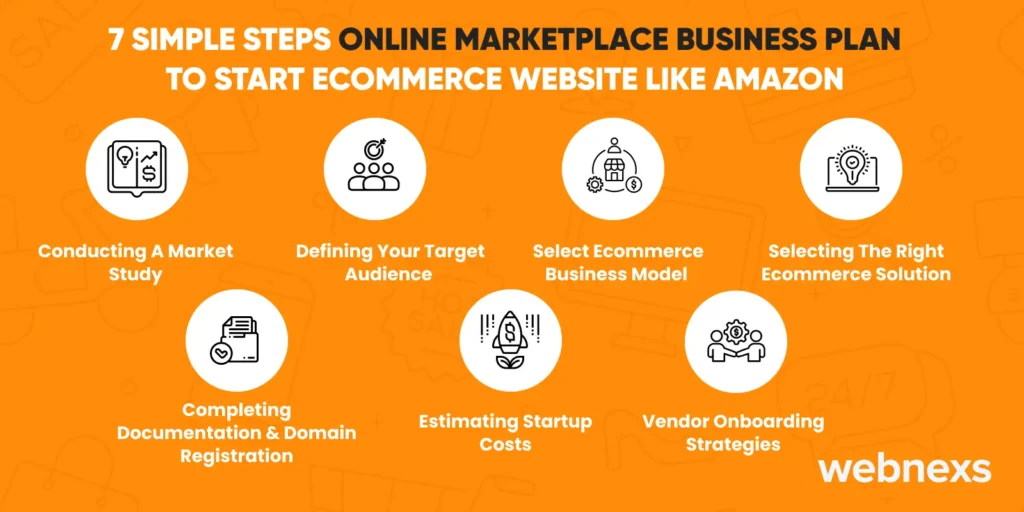
Starting a marketplace business can seem daunting, but breaking it down into actionable steps makes the process manageable. This guide walks you through seven essential steps to create a thriving marketplace, from conducting a market study to estimating startup costs.
Whether you’re planning to launch websites like Amazon or develop an online marketplace business plan, these steps are tailored to help you succeed. Let’s dive into the key areas to focus on as you build your marketplace business!
- Conducting a Market Study to Identify Needs and Bridge Gaps
- Defining Your Target Audience and Geographic Focus
- Choosing the Best Ecommerce Business Model (B2B or B2C)
- Selecting the Right Ecommerce Solution for Your Online Business Plan
- Completing Documentation and Domain Registration
- Estimating Startup Costs for Your Online Marketplace Business
- Vendor Onboarding Strategies for a Successful Marketplace
Step 1: Conducting a Market Study to Identify Needs and Bridge Gaps
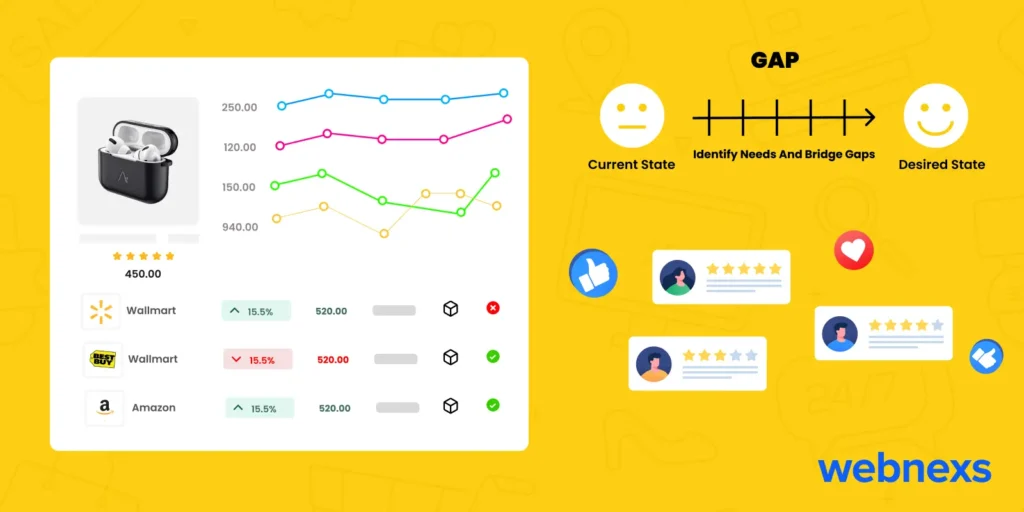
1) Competitor Analysis
There are 3 key components. These are explained below:
- Identifying Key Competitors
While all players in the market are considered competitors, those with higher market shares can pose significant threats in various business aspects, and they should be analyzed to devise a holistic strategy for your business.
- Benchmarking
As already said about high market share competitors, benchmarking against them will help in gaining insights into best practices in terms of strategies, resource allocation, and other aspects.
- SWOT Analysis
The strengths, weaknesses, opportunities, and threats (SWOT) of your competitors will elicit an opportunity for you to focus your attention on the aspects required to compete and gain traction. The success of the multi vendor marketplace business plan is based on this analysis.
2) Customer Behavior Analysis
- Website Analytics
KPIs and metrics are crucial analytical factors for projecting the trajectory of your growth. They need to be monitored and tracked to analyze patterns, identify pain points, and make improvements to stay on track.
- Purchase Journey Analysis
Prepare a customer journey map right from landing on the website to checkout to identify friction points. There are a number of templates available online based on the type of customer journey map, and you can create them to depict the areas needed for improvements.
- Survey and Feedback
Directly interacting with customers to understand their behavior using surveys or feedback forms helps in identifying user intentions, which analytics would not identify. Moreover, this direct feedback can provide insights into the emotional drives behind each purchase decision, which can be used to tailor your plan for starting a marketplace business.
3) Industry Trend Analysis
- Market Research Reports
Use reliable reports from organizations like Forrester, Statista, eMarkerter or others to understand the current industrial trend, to collect figures on the progressive growth, projected growth and other related information.
- Emerging Technologies
Ecommerce is witnessing an increased rate of tech-oriented selling methods that includes AR/VR, voice commerce over devices such as Amazon Alexa, Apple HomePod. You can explore such methods and adopt the most suitable one.
- Social Listening
You need to know what people are opining about. To derive the most optimal ecommerce marketplace business plan, you have to monitor what people are discussing on social media. It provides an open forum for anyone to participate, and platforms like Reddit are a great place to start using tools such as Hootsuite or Brandwatch.
4) Product and Service Gap Analysis
- Product Comparison
A comparative study of your competitor’s product profile will reveal surface-level information on the gap that can be filled by your offering. In addition to this, this analysis can highlight potential areas to capitalize on within your product profile. A unique value proposition can be created that is relatable to your target audience and differentiates your offerings in the market.
- Customer Reviews
By analyzing competitors product reviews, you will gain actual information on what needs to be improved, making your market offering capable of yielding a significant market share. Besides, learning about the pain points, you can also be informed about the features that customers particularly value, which helps in emphasizing the value that is delivered to the customers. You can also consider devising strategies to further align your offerings with the customers requirements.
- Keyword Gap Analysis
The list of keywords your competitors are ranking for will help you identify gaps, based on which you can develop your keyword strategy. Furthermore, knowledge of your competitors keywords can help refine your content and SEO strategies, ensuring that your offerings are visible to the right audience. With this competitive insight, you’ll be better equipped to know how to start a marketplace startup.
5) Demographic and Psychographic Analysis
- Target Audience Analysis
Your audience profile needs to be analyzed to understand the type of users they are, based on age, income level, and other factors, so you can determine your approach accordingly.
- Psychographic Segmentation
Run a cohort analysis to understand your audience’s interests, attitudes, and values to tailor your strategies that most suits your audience. Different segments of your audience can be tracked to find their responses to various marketing strategies over time. You can adapt your approach based on the insights you gain on the evolving interests and behaviors to ensure that the strategy remains relevant, which can drive higher engagement and conversion rates.
6) Pricing and Promotion Gap
- Price Comparison Tools
There is always the possibility of introducing new pricing ranges. This could be for individual products or a bundle of goods, for which there will definitely be niche demand. Pitching such prices will surely generate demand in the business plan marketplace.
- Promotion Strategies
The same concept discussed in pricing can be applied here to gain the attention of your audience in a unique way, which will definitely have an impact. Once you implement strategies that directly resonate with your audience’s preferences, a memorable experience is created that sets your brand apart. As a result, it fosters engagement and connection with your audience, leading to increased loyalty and long-term customer relationships.
7) Supply Chain and Logistics Review
- Shipping and Fulfillment
There could be a potential opportunity in terms of shipping times and costs associated with it. But it requires resources to materialize. To start with, implement a strategy that is small-scale.
- Supplier Network
You need to expand your network of suppliers, but to begin with, within the limits of your resources, identify gaps and take the steps to cover them in terms of product availability or lead times.
The above online marketplace strategies comprise your first step in creating a multi vendor marketplace website like Amazon. This is as simple as this, you identify what your audience wants and you strive to deliver that and even exceed their expectations and you will gain some loyal customer base.
Surprising Fact:
Conducting a thorough SWOT analysis not only identifies your competitors’ strengths and weaknesses but also uncovers untapped opportunities and potential threats. For instance, companies that integrate customer feedback into product development report a 30% higher success rate for new product launches.
Actionable Insight: Regularly perform a detailed SWOT analysis of your competitors and pair it with insights from customer surveys and reviews. This dual approach will enable you to pinpoint gaps in the market, refine your value proposition, and craft strategies that are uniquely tailored to address customer needs and expectations.
Launch Your Multi-Vendor Marketplace Business Today!
Step 2 – Defining Your Target Audience and Geographic Focus
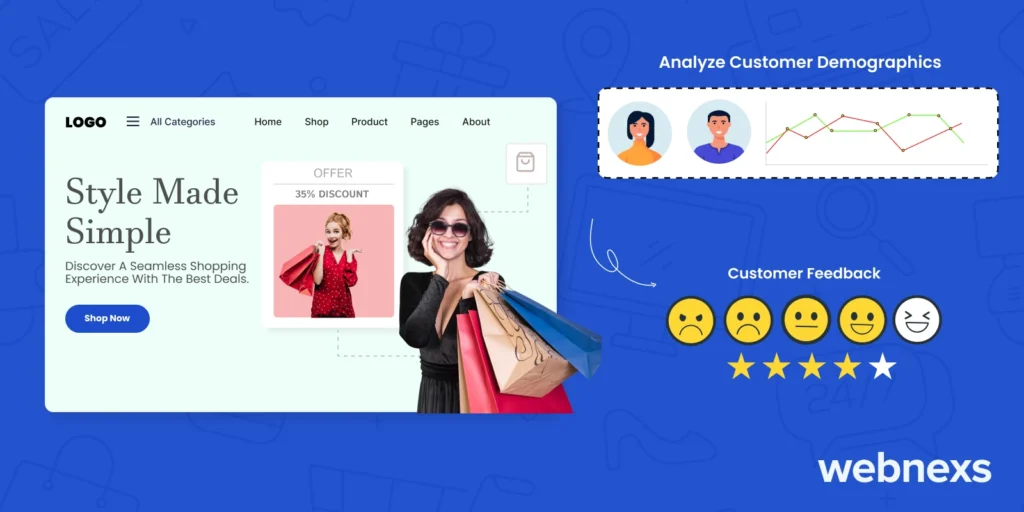
Now that you simply are sure about your business niche, choosing your audience and market geography should be the second step. Well, you can’t expect people to shop from your multi vendor marketplace business model if you don’t know who you’re selling to. A number of the fast questions you ask are:
What’s your online store all about?
Who are the purchasers seeking your business offerings?
What does your online store represent?
Who are your ideal customers?
What’s the foremost preferable geography for your business?
1) Analyze Customer Demographics
Take a look at all the demographics, such as age, gender, income levels, and others as necessary, to get a surface-level idea. You can dive into the specifics once you have a fairly rough understanding to know how to start a marketplace business.
2) Study Your Competitors
Looking at your competitors’ target audience is a major source you can use to easily identify your audience as well. Additionally, identify niche areas, analyze gaps, and serve unrecognized opportunities to differentiate yourself in the market.
3) Psychographic Study
Analyze the interest, lifestyle and habits of your potential target audience and see if it aligns with your goals. This not only helps in identifying your audience but also helps you understand pain points encountered during online purchase which you can convert into an opportunity that you can tap into.
4) Use Social Media Insights
Use platforms like Instagram and Facebook to understand various groups of people, and utilize social listening to gather further insights for your online marketplace business plan.
5) Monitor Customer Feedback
Customers share their reviews and feedback on social media and ecommerce platforms, so dive into those to gather a pool of data.
This is a crucial element of your multi vendor marketplace business plan, as the choice will either drive your business towards growth or setback. The right market offerings must reach the right audience.
Surprising Fact:
Businesses that invest in detailed psychographic analysis and leverage social media insights see a 20-30% higher customer engagement rate compared to those that rely solely on demographics. Understanding customer behavior and preferences enables businesses to align their offerings more effectively with audience expectations.
Actionable Insight: Incorporate a mix of demographic and psychographic analysis tools, such as Google Analytics and social media insights, to better understand your target audience. Use this data to create highly personalized marketing campaigns and identify underserved niches in your multi-vendor marketplace.
Step 3 – Choosing The Right Ecommerce Business Model (B2B/B2C)
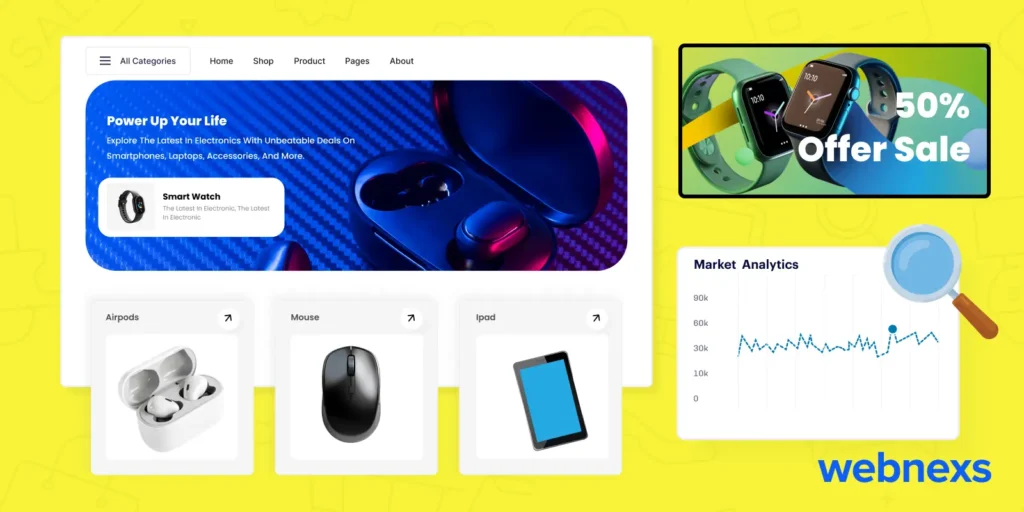
If you’re getting to start an online marketplace platform like Amazon, you ought to thinChoosing the right ecommerce business model is the utmost important step to start an online marketplace platform. B2B online stores require enterprise-grade features, streamlined business processes, and a managed dashboard for manufacturers, distributors, brand owners, and retailers.
Both B2B and B2C require user-friendly features, but B2C stores require more of them to possess the capabilities to handle the height load.
1. Analyze Your Product Offering
- B2B
Bulk purchasing requirements, specialized equipment, and machinery will require a business-to-business marketplace model. Here, the emphasis is more on customization or technical integration.
- B2C
If the products or services are consumable on a day-to-day basis whose end users will be individual buyers then you should opt for a B2C ecommerce marketplace. Here, the emphasis is on ease of use and quick satisfaction.
2. Assess Market Demand
- B2B
Conduct market research to analyze demand patterns within industries and bring out the answers to such questions as: is there demand for your offerings in large quantities? At which stage of their supply chain there is a gap that can be filled with your offerings? And many more.
- B2C
For your product offering, you need to analyze whether there are preferences, volume of consumption, consumption patterns, frequency of purchase, and other factors to get an overview of the type of business growth that you will have.
3. Evaluate Customer Buying Behavior
- B2B
The purchasing patterns are planned, repeatable, have higher lead time, and are usually driven by long-term relationships. All of these require relationship management tools and contracts.
- B2C
Usually, purchases are impulsive, irregular, and in small quantities, and it requires extra effort to persuade the users to convert sales. Recognizing customer behavior
4. Study Competitors and Industry Trends
Common B2B/B2C Factors To Consider
Make an analysis of your competitor business model, observe industry trends in both models, assess growth potential, identify gaps to promote your offerings, and consider technological aspects. Touching on all of these will help in capitalizing on them for B2B online marketplaces and the other models.
5. Understand the Sales Cycle and Transaction Size
- B2B
Usually, the sales cycles tend to be longer, with more negotiations, higher transaction values, and complex payment terms. Inspect whether you are willing to invest in these necessary resources.
- B2C
The focus is on high-volume, fast-paced transactions with lower values. Consider whether this aligns with your business goals and strategies when developing your business plan for an ecommerce website.
6. Consider Pricing and Profit Margins
- B2B
Set your financial goals and evaluate them based on volume, margins, and customer needs. This model often involves negotiated pricing and larger margins per transaction but has a lower volume.
- B2C
It is based on fixed pricing and higher volumes that contribute to margins at lower levels. Consider keeping flexible pricing as part of your online marketplace strategy, as there is high competition.
7. Leverage Existing Resources and Expertise
Common B2B/B2C Factors to Consider
If you already possess a strong network of connections with businesses or have experience in B2B sales, then you can make this your starting point to enter into this model. If this factor applies to B2C, then they would be considered viable for your online marketplace strategy.
You can always diversify your business to cater to a wide range of audiences, similar to an Amazon ecommerce business plan, but in the initial phase, it is imperative to target the audience based on the resources to ensure their optimal use and to prevent any capital lockups and financial bottlenecks.
Whether you opt to create a B2B or B2C business model, Webnexs can assist your success as have already built many successful online marketplace websites and stores with the best marketplace business plan that set the clients to scale their online business.
Surprising Fact:
B2B ecommerce transactions typically involve longer sales cycles, higher transaction values, and complex payment terms, while B2C transactions focus on fast-paced, high-volume sales with lower individual transaction values. Yet, B2B marketplaces often deliver larger profit margins per transaction compared to the B2C model.
Actionable Insight: Align your ecommerce strategy with your target model prioritize CRM tools and tailored pricing for B2B or user-friendly design and marketing for B2C. Focus on market demands, customer behavior, and sales dynamics to maximize growth and profitability.
Simplify Your Ecommerce Marketplace Business Model!
Step 4 – Selecting the Right Ecommerce Solution for Your Online Business Plan
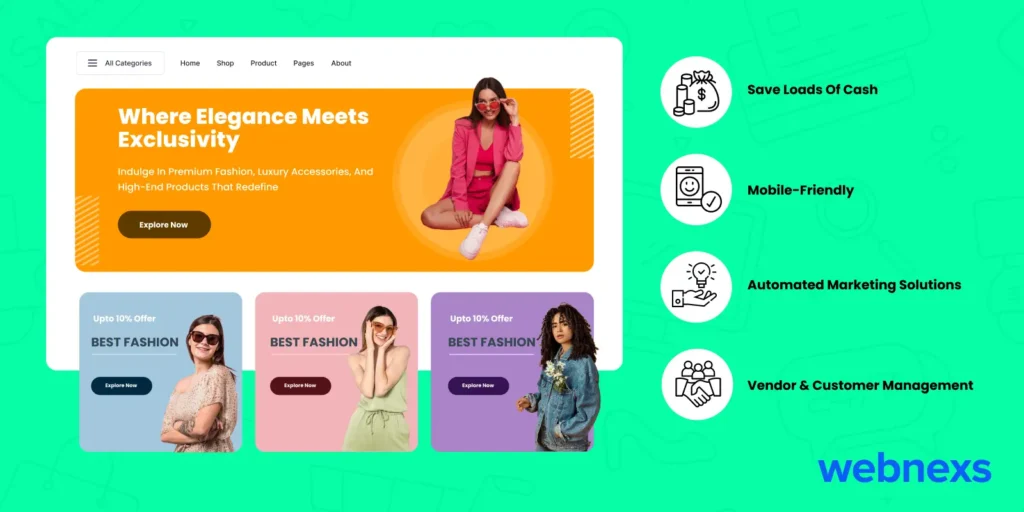
Now, it’s time to travel ahead withWhile building a multi vendor marketplace business model, either build the website from scratch or build it with a fully built and managed ecommerce solution.
Let’s mention the difference between building from scratch and a pre-built ecommerce platform. There are many advantages of pre-built platforms over building your website. A number of them are:
- Save loads of cash
- Saves hiring of IT resources
- Automated marketing solutions
- Integrated payment and logistics
- Mobile-friendly
- Vendor and customer management
- Ready-made beautiful website themes for your business, and tons more.
For example, if you are into online fashion, you’ll choose a colorful website with tons of space to accommodate visual content. You’ll not waste time and resources building the website from scratch. With Webnexs Headless Ecommerce, you’ll simply fiddle with the ready-made themes, technology, and solutions that will assist you in achieving online success.
Surprising Fact:
Pre-built ecommerce platforms can reduce initial development costs by up to 70%, eliminate the need for extensive IT hiring, and provide access to advanced features like automated marketing, integrated payments, and mobile-friendly design features that would take months to develop from scratch.
Actionable Insight: Opt for a pre-built headless ecommerce solution to launch your online multi vendor marketplace quickly and cost-effectively. Focus on customizing ready-made themes and leveraging built-in tools for vendor management, logistics, and marketing automation to create a scalable and visually appealing platform that meets market demands without overburdening your resources.
Step 5 – Completing Documentation and Domain Registration
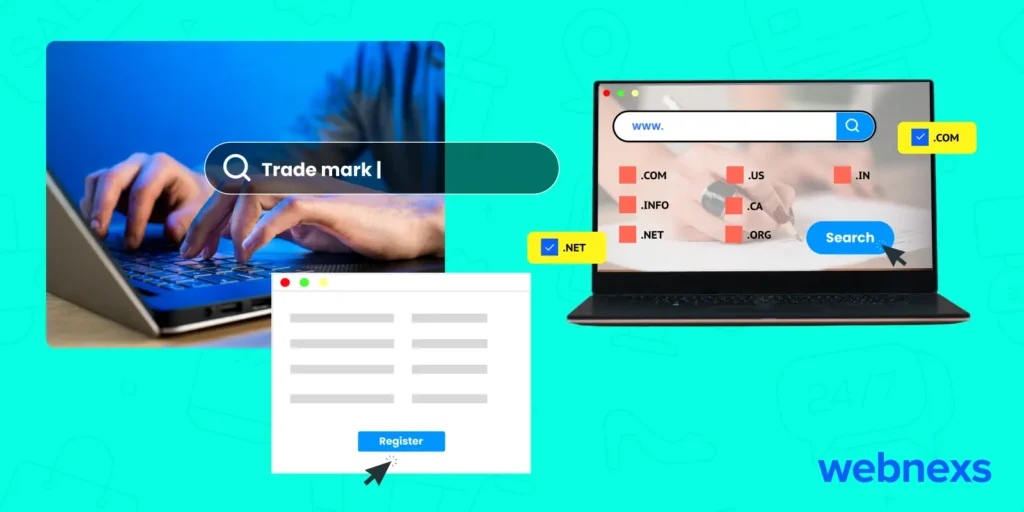
Now, it’s time to travel ahead with one of the foremost crucial parts of starting an online business: registering and completing the legal formalities.
- Apply for the director’s number with the necessary documents
- Collect the Permanent Account Number (PAN) and Digital Signature Certificate(Indian standards)
- Decide on the corporate name
- Apply to the corporate name registration
- Register a perfect domain for your online business
- Apply for the products and repair Tax (GST) certification(Indian standards)
1) Choose a Memorable and Relevant Domain Name
- Relevance
A name that has meaning creates an impact, additionally, when there is a touch of creativity it makes a lasting impact. For instance, consider Amazon’s name which directly reflects the goal of being a marketplace for everything.
- Keywords
Keywords that represent your business can be included, otherwise called Exact Match Domain. However, its significance in determining ranking positions has reduced over the years and factors such as brand authority, content relevance, and user experience have gained more influence. It can still enhance your ranking indirectly.
- Keep It Simple
An ideal name is simple, easy to remember, and consists of two syllables. This allows people from various linguistic backgrounds to pronounce it easily.
- Domain Extensions
If you choose not to go with Exact Match Domain words, then you can consider alternatives to ‘.com’ for your top-level domain, such as ‘.store’ or ‘.shop,’ to explicitly create awareness that yours is an ecommerce platform. These increase the chances of CTR (click-through rates).
2) Trademark and Legal Protection
- Trademark Search
Perform a trademark search before purchasing a domain to ensure it is available for use to protect yourself from legal issues in the future.
- Register the Trademark
Now that your domain is secured, your business name can be registered as a trademark for added legal protection.
3) Select a Reliable Domain Registrar
- Reputation and Support
Consider a registrar with a good reputation, strong security protocols, and responsive customer support as your primary factors in selecting a provider for your business, especially when developing your multi vendor marketplace business plan.
- Privacy Protection
For privacy concerns, otp for privacy protection services offered by registrars to keep information from getting tampered and eliciting unsolicited contact.
4) SSL Certificate and Security
- Secure Domain (SSL)
Protecting your customer data with an SSL certificate i.e., HTTPS is mandatory and it is also considered an important ranking factor for SEO.
- Security Strategy
When starting a marketplace business, devise a security strategy to implement firewalls, anti-malware software, and regular updates for data protection.
Your domain name should be at the forefront of the minds of your target audience, as this will elicit a positive response. A good name will aid in word-of-mouth marketing, where the success will not only be attributed to your expertise but also to the fact that the name is memorable.
You can also stop to get these, operate your business, and generate revenues first. Once your revenue wheel is in, you can start ahead in these areas.
Surprising Fact:
Businesses that register a memorable and relevant domain name can experience a 25% higher click-through rate (CTR) compared to those with generic or less intuitive names. Additionally, securing an SSL certificate not only protects customer data but can boost search engine rankings by up to 30%.
Actionable Insight: Prioritize choosing a domain name that is simple, relevant, and memorable to improve user recall and marketing impact. Complement this with an SSL certificate to enhance security and SEO performance. For long-term growth, perform a trademark search and secure legal protections to safeguard your brand from future disputes, ensuring a solid foundation for scalability and credibility.
Step 6 – Estimating Startup Costs for Your Online Marketplace Business
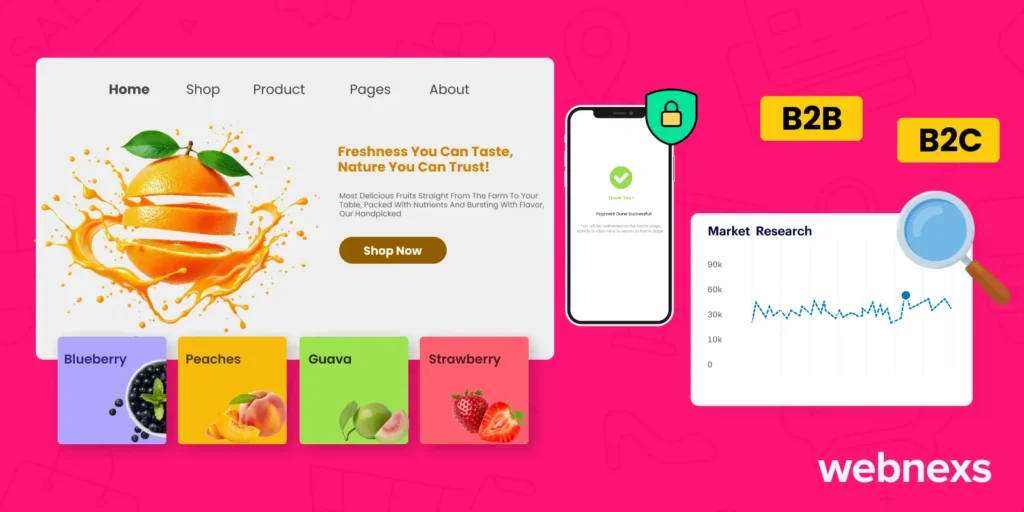
Simply said, you would like not to incur heavy costs to starting a marketplace business platform if you’ve chosen to create it on Webnexs. Still, some factors to be considered are:
- Choice of B2B, B2C, or any out-of-the-box business models
- Project complexity and customizations
- Choice of the answer – custom-built, turnkey solution with plugins, fully-hosted and managed multi-vendor solution
- Additional requirements like mobile apps etc.
1. Initial Market Research
Conduct studies in the form of surveys to understand the payment cap that customers are willing to pay; this helps in reducing unnecessary spending.
2. Platform Development Costs
Estimate costs associated with a custom-built platform or a white-label solution. This includes the design, development, testing, and deployment of the platform, including hiring developers or agencies.
3. Technology Infrastructure
Storage of your ecommerce platform as an infrastructure can be hosted on-premises or using the cloud. One factor to consider is scalability, as this greatly determines the costs associated with your user platform as it grows.
4. Legal and Compliance Expenses
Legal services related to business formation, compliance, and other matters require separate budgeting. Factor in all of these costs, as they are inevitable.
5. Payment Processing Setup
Secure payment gateways should be implemented, and the estimation of ongoing transaction fees needs to be considered, as this will impact your costs as transactions occur.
6. Marketing and Launch Costs
In the initial phase, start with budget-friendly marketing efforts to build awareness and attract buyers. Some examples include referral programs or discounts for early adopters.
Gathering information from the right sources will help you arrive at the right estimation. Apart from the types of costs mentioned above, you also need to set aside money as a buffer to cushion unexpected financial circumstances in this multi-vendor marketplace business model.
One of the foremost common reasons for the recognition of the online marketplace on ecommerce platforms is its low setup costs. Don’t think anymore about building your marketplace website with Webnexs. Inspect the pricing on various online marketplace business plans for your multi-vendor website now.
Surprising Fact:
Building a marketplace website like Amazon doesn’t always require exorbitant costs. Opting for solutions like Webnexs can significantly lower setup expenses compared to traditional approaches. Moreover, the scalability of cloud-based infrastructure ensures cost-efficiency as your user base grows.
Actionable Insight: Choose a turnkey or fully-hosted multi-vendor solution to minimize upfront costs. Focus on scalability with cloud infrastructure and utilize budget-friendly marketing strategies like referral programs to attract early adopters, ensuring sustainable growth without overspending.
Step 7 – Vendor Onboarding Strategies for a Successful Marketplace
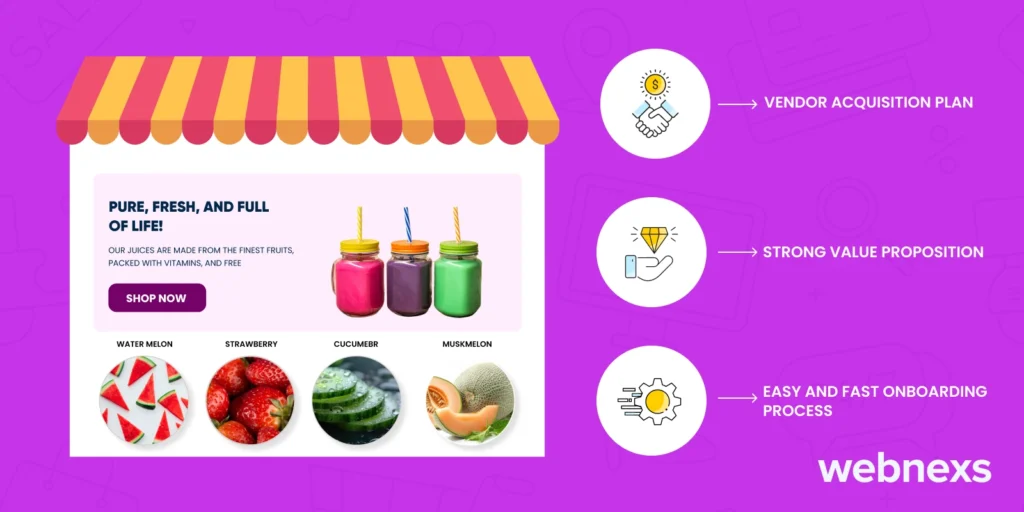
If you’re getting to start an online marketplace website like Amazon, you ought to think scalable and profitable right from the beginning. Vendors are your indispensable assets, and they are those who drive your online marketplace.
For an equivalent reason, the onboarding of vendors is a vital step. You’ll face tons of competition in selling products online. It’s not all, easy but quick vendor onboarding is the requirement.
1. Create a Vendor Acquisition Plan
You can start by targeting small businesses by incentivizing or offering a reduced commission rate for their onboarding procedure with you, as they are more likely to approach you. Once you gain traction in the industry, you can reach out to large companies after you have gained enough visibility.
2. Create a Strong Value Proposition
Give compelling reasons to your vendors to join your online marketplace platform. Highlight access to a large customer base, marketing support, or faster payment options.
3. Provide an Easy and Fast Onboarding Process
For all the operations that the vendor needs to perform in your platform provide step-by-step guides or video tutorials to educate to assist them in managing their online store.
4. Offering Training and Support
In the initial phase, you can start by displaying FAQs that focus on the intricacies, and once you start to grow, you can assign vendor account managers to offer personalized guidance and support.
This includes providing strategies for managing stock levels, forecasting demand, offering advice on efficient order processing, packaging, and shipping methods, and more. Doing so will help you create a multi-vendor marketplace website like Amazon.
Your part doesn’t end with merely associating with vendors but also with delivering a smooth onboarding process with proper orientation. This stage is crucial as it sets the tone of their relationship with your platform.
With Webnexs multi vendor marketplace software, multiple vendors can be easily onboarded by offering an easy registration process and ensuring bring true value to the market.
Surprising Fact:
Streamlined vendor onboarding can significantly impact the success of an online marketplace. Studies show that marketplaces with faster and more transparent onboarding processes experience up to 50% higher vendor retention rates within the first six months. This directly contributes to a scalable and profitable platform.
Actionable Insight: Design a seamless vendor onboarding process with clear guides, video tutorials, and FAQs. Start by targeting small businesses with incentives like reduced commissions. As your marketplace grows, assign dedicated account managers to provide personalized support and foster vendor loyalty.
Why Choose Webnexs to Create a Multi Vendor Marketplace Website like Amazon Platform?
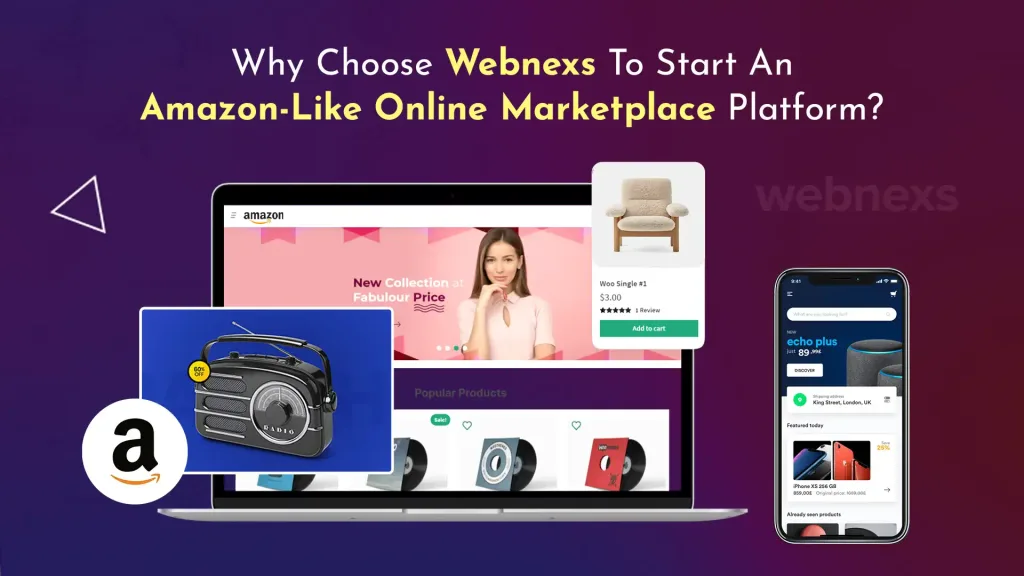
The win-all formula of an online business plan marketplace like Amazon is here to remain, and we want you to form the foremost out of it. Webnexs offers a scalable marketplace solution and comes loaded with over 300 inbuilt features for your online business.
Choosing the ready solution for your multi-vendor marketplace helps you begin your online business at a fraction of the value of building it from scratch.
Webnexs has the multi-faceted expertise of building and managing a spread of vertical and horizontal marketplaces for B2B also as B2C businesses. The platform is extremely flexible to assist businesses in implementing out-of-the-box models with customized solutions.
Read More: Ecommerce Marketing Plan: How To Develop One For Your Startup?
Conclusion
Developing a strong online marketplace business plan is the foundation for building a successful platform like Amazon.
Start by understanding your target audience and creating a value proposition that stands out. Invest in reliable, scalable technology to keep your operations smooth and efficient. To thrive in a competitive market, focus on strategic marketing and delivering an excellent customer experience.
A clear and actionable plan will help you launch, grow, and adapt your marketplace to industry trends. Need help getting started? Contact Us for expert advice we’re here to guide you every step of the way!
